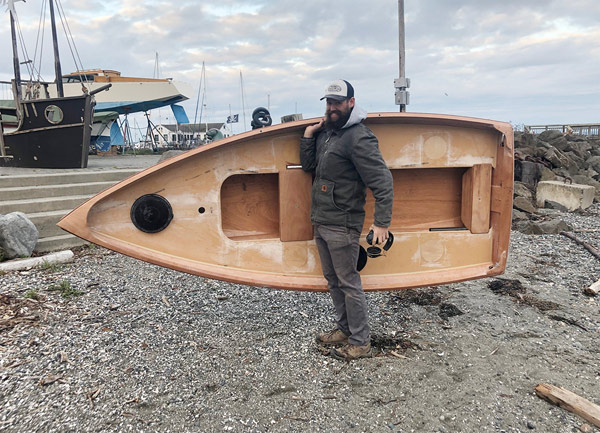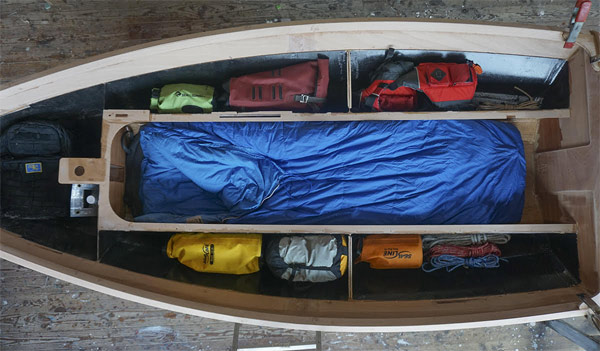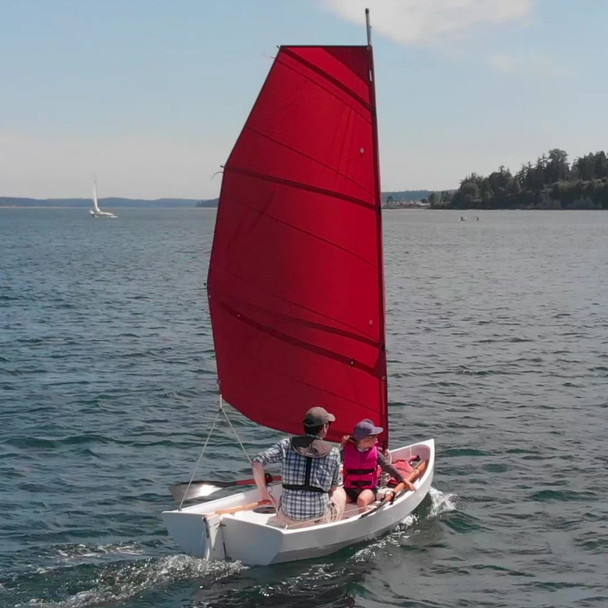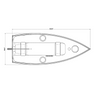Description
Kit includes:
All BS 1088 marine grade plywood and marine grade foam parts—hull, decks, seats, etc
Scout
Simplicity means the achievement of maximum effect with minimum means. —Koichi Kawana
What does the smallest possible camp-cruising sailboat look like? If larger cruising keelboats are akin to motorhomes, what does a backpacker’s boat look like? Just how small can one go, practically speaking?
Over the past couple years Duckworks and Turn Point Design have collaborated to develop another boat that’s as small as it could be to serve its intended purposes—the 6’ 10”, 35-pound Portage Pram. When we decided to offer an optional sailing rig for the tiny pram we knew everything superfluous would have to be stripped away. The bold solution was a modern-but-simple, full-battened, boomless, square-top sail.


In consultation with Bob Pattison at Neil Pryde, we specified a sleeved sail that slipped over a simple two-piece windsurf mast. The final product was remarkable. The Pram takes less than three minutes to rig, and the gorgeous battened sail offers amazing performance on all points—with a nice wing shape, and steady handling even in gusts as the square top cracks off to release excess pressure.
Sailing the Pram is a blast, but Brandon Davis and I both had the same initial reaction—we immediately imagined something a little bigger and more comfortable that used the same type of rig.
All of this got us talking again about the perfect small boat for our purposes. If there’s one thing using the Pram this summer proved, it’s that light, car-toppable boats get more use than bigger boats. But we love overnighting, cruising, and distance adventuring—none of which are especially compatible with the Pram. Obviously we’d need something larger.
Here was our dream wish list for this new boat we call Scout:
1. Light enough to cartop
2 .Safe boat with lots of flotation
3 .Especially quick to rig
4 .Sails and rows well
5 .Lots of dry stowage
6 .Room to sleep aboard
It was an interesting design exercise, as some of these features—like car-topping and sleeping aboard—would seem mutually exclusive. But before long Brandon was producing drawings that seemed to tick all of the boxes and, most remarkably, with judicious use of closed-cell foam panels to augment the 4mm plywood, he estimated we could keep the boat down under 70 pounds.

After Brandon’s design work and preparing CNC files, Turn Point cut the prototype kit and Northwest Maritime Center boat shop manager Joel Arrington got to work immediately. With pre-drilled holes for stitching with zip ties, puzzle joints planks, and scribe marks identifying parts and proper alignment, Joel reported the kit goes together nearly as fast as our little Portage Pram, which can be built in just a few days. The 4mm plywood kit also includes a puzzle-joint foam deck and foam filler-pieces sandwiched at transom, in knees, and in a brilliant boxed inwale.
Lifting the finished boat was a shock, as even with two layers of glass inside the cockpit sole and on the bottom, the prototype came in at only 65 pounds! Scout is indeed truly car-toppable—no need for a trailer.
Looking for a roomy cockpit? How about 52” of beam and a deep, totally unobstructed footwell (the daggerboard is offset). And how many 10-foot cartoppers offer a sleeping bunk? The Scout footwell measures 20 3/8” wide by 81.5” long—not a luxurious berth, but wider than the traditional British sailboat bunk and much longer. Want more space? Use a cloth, hammock or filler boards over footwell to create a double bunk.
Safety? Imagine a wide, stable, 10-foot boat with six different discrete watertight, bulkheaded chambers under decks.

The boomless, unstayed rig that is simple and safe, and she is designed to row easily (oars stow out of the way under the lip above footwell). And those locking rowing thwart/seats are moveable. Not rowing? Slide them out of the way or position them so that you can sit on the cockpit sole and lean back comfortably against the slanted forward panel—slide the second thwart over in front of you to use as a table or cook station.
Stowage? Checkout the photo before the decks went on. Obviously the deck access plate diameter will limit the size of gear, but the photo gives you an idea of the tremendous dry stowage volume.
As the ultimate mini beach-cruiser, Scout features modern NACA profile, high-performance. foam-core rudder and off-daggerboard. After more testing we’ve settled on a reefable 60 square-foot sail for Scout—the sweet spot for performance and manageability. (Photos show the smaller Portage Pram rig being used on prototype)

We’ve just started testing the prototype and can report sparkling performance on all points. Scout it stable, responsive, and appears very ready to plane. We’ll have additional reports and video soon.
Rowing performance was also fantastic. At only 65 pounds, with her buoyant hull and thoughtful lines, Scout was effortless to pull. And having listed all of these virtues, we’ve failed to mention Scout’s obvious suitability as a lightweight rowing-only tender. She would also make an excellent youth sailboat trainer (or building project).
Scout’s light weight also pays dividends when it comes to shipping.
We’re also talking about a potential mini-fleet of Scouts for the 2021 Salish 100 and Texas 200 events this coming summer.
































